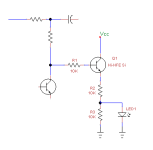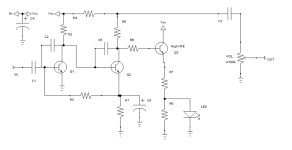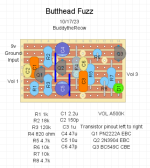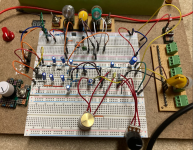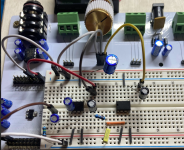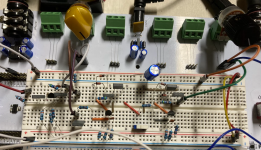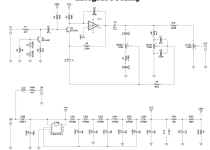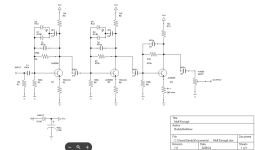BuddytheReow
Breadboard Baker
Alright. Here's version 3 of the Spooky Dookie.
R3 changed to 68k. Diodes swapped out to 1n4148 (standard). BITE control changed to a C20k (100k was too much and I didn't have a 50) and acting as a voltage divider which can dial out the clipping. Once you dial the diodes out the volume goes up quite a bit, but that can be tamed. VOLUME upped to A250k. Thanks for looking out @Chuck D. Bones
I think this may be called done since I don't think there's much more I can do unless someone wants a go at it. It gets loud (booster), a bass and treble control, and clipping control for just a 1 transistor circuit. It's been sitting on my breadboard for a week, but I haven't had much time playing though it (maybe 10-15 min). This was a cool little project to put together some little circuit Legos. Maybe someone will make a PCB for this some day. I may commit this to vero or I may not. I've got a lot of house projects right now, so this is on the back burner for a bit.

R3 changed to 68k. Diodes swapped out to 1n4148 (standard). BITE control changed to a C20k (100k was too much and I didn't have a 50) and acting as a voltage divider which can dial out the clipping. Once you dial the diodes out the volume goes up quite a bit, but that can be tamed. VOLUME upped to A250k. Thanks for looking out @Chuck D. Bones
I think this may be called done since I don't think there's much more I can do unless someone wants a go at it. It gets loud (booster), a bass and treble control, and clipping control for just a 1 transistor circuit. It's been sitting on my breadboard for a week, but I haven't had much time playing though it (maybe 10-15 min). This was a cool little project to put together some little circuit Legos. Maybe someone will make a PCB for this some day. I may commit this to vero or I may not. I've got a lot of house projects right now, so this is on the back burner for a bit.




